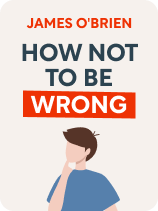

This article is an excerpt from the Shortform book guide to "How Not To Be Wrong" by James O'Brien. Shortform has the world's best summaries and analyses of books you should be reading.
Like this article? Sign up for a free trial here.
If you experience trauma in childhood, how might that affect you as an adult? What’s a “survival personality”?
In How Not to Be Wrong, James O’Brien tells how the trauma he experienced as a child shaped his life as an adult. We compare O’Brien’s perspectives to those found in books such as What Happened to You? and The Body Keeps the Score, which take a more clinical approach to some of the same issues.
Keep reading for a discussion of unresolved trauma in adults, starting with O’Brien’s own experience.
James O’Brien’s Story
Although he’s done a lot of healing and growing in recent years, James O’Brien is an example of what unresolved trauma in adults can look like. O’Brien, who was adopted, was sent to an all-boys boarding school, where the headmaster regularly beat him for years. O’Brien always defended the practice by saying that he turned out OK. He didn’t believe he was harmed by it. In fact, he frequently bragged about the beatings, treating the experience as a badge of honor that demonstrated his toughness. The truth is that O’Brien was in denial about how much pain and humiliation the beatings had caused him. In response, he developed what he calls a “survival personality” to protect himself, and it became the basis for his success. In the process, however, he abandoned his true self.
The corporal punishment inflicted on O’Brien in childhood primed him to constantly be on the alert for attack, so, as an adult, even small issues caused him to overreact. Aggression became a way of life. He extrapolates from his own experiences that our early, unconscious defense mechanisms can become our entire personality and way of relating to the world.
O’Brien has recognized this same dysfunction in other people: On his radio show, O’Brien spoke with callers who had also developed coping mechanisms to survive childhood adversity. For example, a former gang member called in to his show and explained how as a 16-year-old, he had to get past a gang just to leave his flat. If you weren’t in the gang you got beatings every day, he said, so it was easier to join them. He adapted in order to survive, but, as an adult trying to hold down a regular job, those adaptations weren’t working for him. He was struggling to stay away from the criminal life that he knew so well. Like O’Brien, this caller had developed armor to protect himself from the circumstances of his childhood, but as an adult, it was becoming harder to move through the world with so much armor on.
Early Childhood Trauma and Adult Trauma Responses
O’Brien’s experiences of being abused as a child and then being constantly anxious and aggressive as an adult are very common among trauma survivors. Psychological research gives clinical names to much of what O’Brien describes. For example, what O’Brien calls a “survival personality” is often called a “trauma response” in the literature on trauma. When O’Brien talks about being in constant “fight or flight” mode, ready to react aggressively to the smallest provocation, psychologists might say he had Post Traumatic Stress Disorder (PTSD) and was experiencing trauma “triggers.”
Psychiatrist Bessel van der Kolk, in his best-selling book The Body Keeps the Score, provides a scientific explanation for why O’Brien feels the way he does. Van der Kolk explains that traumatic experiences actually rewire the brain to make people hypervigilant to threats. The slightest hint of a threat sends trauma survivors into a fight-or-flight response, causing stress hormones to flood their bodies and keep them in a state of hyperarousal long after the threat is gone. Like O’Brien, they are constantly on the alert for attack and, as a result, often perceive threats where there are none, responding aggressively without any real provocation.
According to van der Kolk, however, talk therapy (as used by O’Brien) is often inadequate as a sole form of treatment for trauma survivors, because revisiting their trauma brings up overwhelming emotions that can re-traumatize them. Instead, van der Kolk advocates seeking out physical experiences that connect the body and mind. Because trauma makes people feel hyperarousal and a lack of control over their bodies, helping survivors regain that control is important to healing. Examples of such healing modalities include psychomotor therapy, neurofeedback, and yoga.
In What Happened to You? Bruce D. Perry and Oprah Winfrey provide a similar explanation for how trauma affects the brain and behavior. They place particular emphasis on childhood trauma, explaining that its effects are more severe and long-lasting because the brain is still developing during this time. Childhood trauma can thus impede healthy brain development. To heal from childhood trauma, Perry and Winfrey advocate leaning on your community and only revisiting your traumatic experiences in small doses, among other approaches.

———End of Preview———
Like what you just read? Read the rest of the world's best book summary and analysis of James O'Brien's "How Not To Be Wrong" at Shortform.
Here's what you'll find in our full How Not To Be Wrong summary:
- Why learning to change your mind is a valuable skill
- How to combat prejudice and gain empathy for others
- Why you should take a step back and reexamine your beliefs






